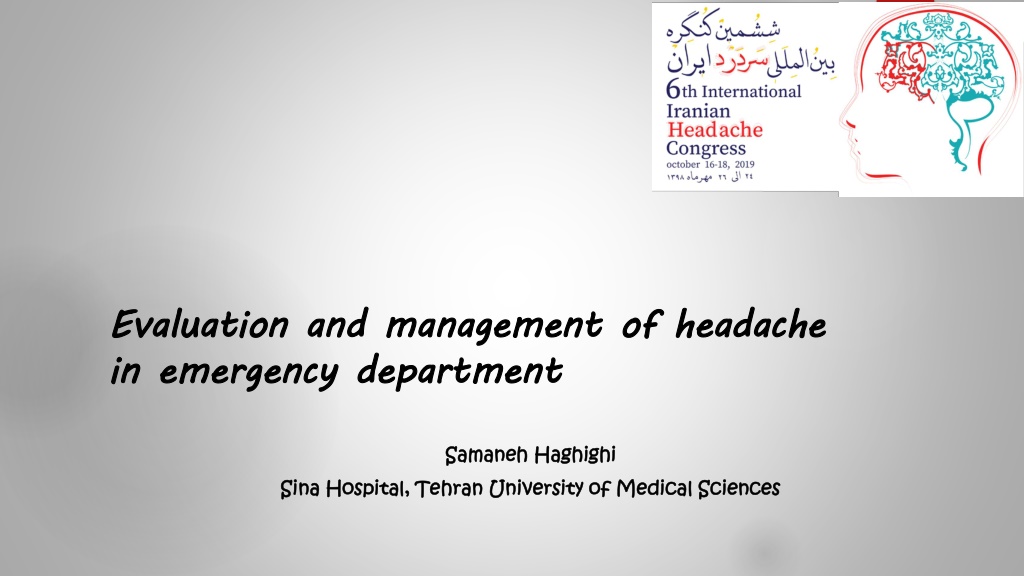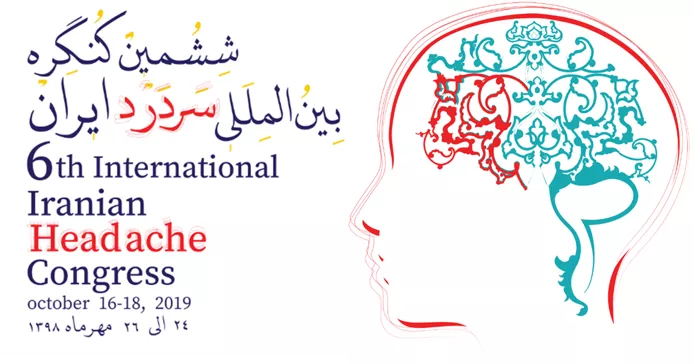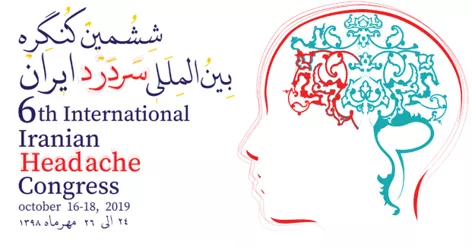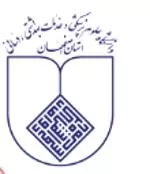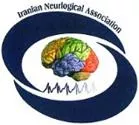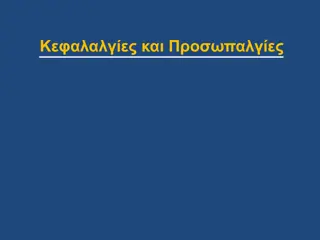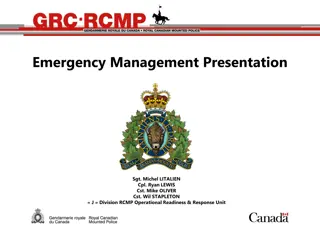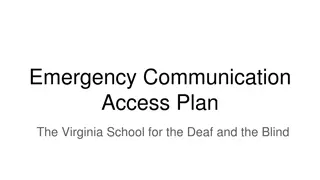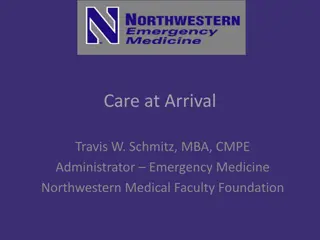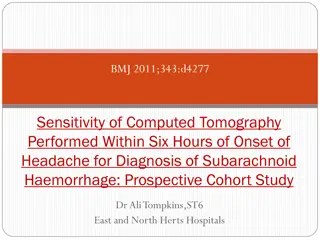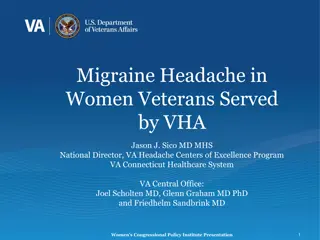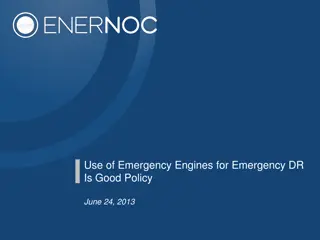Evaluation and Management of Headache in the Emergency Department
Headaches unrelated to trauma account for 2% of emergency department visits. It is crucial to differentiate between patients with life-threatening headaches and those with benign primary headaches. History and physical examination play a vital role in assessing and diagnosing patients with high-risk features. Sudden onset and severe persistent headaches raise red flags for urgent evaluation and diagnosis, as timing is critical to identifying potentially serious conditions such as subarachnoid hemorrhage.
Download Presentation

Please find below an Image/Link to download the presentation.
The content on the website is provided AS IS for your information and personal use only. It may not be sold, licensed, or shared on other websites without obtaining consent from the author. Download presentation by click this link. If you encounter any issues during the download, it is possible that the publisher has removed the file from their server.
E N D
Presentation Transcript
Evaluation and management of headache in emergency department Evaluation and management of headache in emergency department Samaneh Samaneh Haghighi Haghighi Sina Sina Hospital, Tehran University of Medical Sciences Hospital, Tehran University of Medical Sciences
Headache unrelated to trauma: 2% of emergency department (ED) visits
The differentiation of the small number of patients with life- threatening headaches from the overwhelming majority with benign primary headache is an important problem in the ED. Failure to recognize a serious headache can have serious consequences including permanent neurologic deficits, loss of vision, or death.
the most important part History and physical examination most important part of the assessment History and physical examination Maintain your calm, and remember that their greatest asset is the ability to take a careful history, even in the chaos of a busy ED on a Saturday night.
Patients who have one or more high-risk historical features or examination findings are considered to have a life threatening condition requiring urgent diagnosis
High High- -risk historical features risk historical features Sudden onset A severe persistent headache that reaches maximal intensity within a few seconds investigation. Sudden onset headache seconds or minutes minutes after the onset of pain warrants aggressive
High High- -risk historical features risk historical features it is unclear over what time a headache may crescendo and still be caused by an SAH; furthermore, patients sometimes find it difficult to be sure whether their headache did get worse over time, especially if it was bad to start with and they are vomiting and distressed. All first or worst headaches arising within a few minutes or so require referral and investigation, although the odds of SAH fall with virtually every passing minute of a truly crescendo headache.
Etiologies of thunderclap headache Etiologies of thunderclap headache Most common causes of thunderclap headache: Subarachnoid hemorrhage Reversible cerebral vasoconstriction syndromes (RCVS) Most common causes of thunderclap headache:
Conditions that less commonly cause thunderclap headache Conditions that less commonly cause thunderclap headache Cerebral infection (eg, meningitis, acute complicated sinusitis) Cerebral venous thrombosis Cervical artery dissection Spontaneous intracranial hypotension Acute hypertensive crisis Posterior reversible leukoencephalopathy syndrome (PRES) Intracerebral hemorrhage Ischemic stroke
High High- -risk historical features risk historical features Concomitant infection extracranial infection(such as the lungs or the paranasal or mastoid sinuses) may serve as a nidus for the development of meningitis or intracranial abscess Concomitant infection
High High- -risk historical features risk historical features Altered mental status or seizure Preeclampsia and PRES can cause headache and seizure Headache with exertion artery dissection, Reversible cerebral vasoconstriction, or intracranial hemorrhage Age over intracranial mass lesion and temporal arteritis Altered mental status or seizure Space occupying lesion, SAH, Headache with exertion (eg, sexual activity, exercise) Carotid Age over 50 50 significantly greater risk of a dangerous cause
High High- -risk historical features risk historical features Visual disturbances Acute angle closure glaucoma, present with a complaint of headache. Headache associated with visual disturbances Giant cell arteritis, idiopathic intracranial hypertension, and PRES. Visual disturbances
High High- -risk historical features risk historical features Pregnancy and postpartum state most common cause: primary headache syndromes In secondary causes: Preeclampsia is the most common Less common etiologies include venous sinus thrombosis, pituitary apoplexy, and reversible cerebral vasoconstriction. Postpartum Positional headache: postdural puncture headache (if the patient had a spinal anesthetic) spontaneous intracranial hypotension (in patients without a spinal anesthetic) due to Dural tears due to labor-related pushing Pregnancy and postpartum state
High High- -risk historical features risk historical features Medications: analgesics. Medications: Anticoagulants, glucocorticoids, oral contraceptives, and Illicit drugs agents, increase the risk of stroke and intracranial bleeding. If the drugs are used intravenously, brain abscess is another Illicit drugs cocaine, methamphetamine, and other sympathomimetic
High High- -risk historical features risk historical features Toxic exposure coworkers and improve rapidly in the emergency department (ED) without intervention, particularly during winter months, raise the possibility of carbon monoxide poisoning Toxic exposure Headaches that involve multiple family members or
High High- -risk historical features risk historical features Explosive onset and severe at onset No similar headaches in the past Concomitant infection Altered mental status or seizure Associated with exertion (eg, exercise, sexual intercourse) Age over 50 Immunosuppression (eg, HIV, chronic glucocorticoid therapy) Visual disturbances Pregnancy or postpartum state Medications or illicit drugs (eg, anticoagulants, sympathomimetic agents)
High High- -risk examination findings risk examination findings Abnormal vital signs Neurologic abnormalities Decreased level of consciousness Meningismus Papilledema or other ophthalmologic findings
High High- -risk examination findings risk examination findings Abnormal vital signs Decreased level of consciousness Neurologic abnormalities asymmetry, unilateral pronator drift, visual filed cut, or extensor plantar response,unilateral vision loss, ataxia. Meningismus Abnormal vital signs Decreased level of consciousness Neurologic abnormalities may be quite subtle, such as slight pupillary Meningismus: less specific in > : less specific in >60 60 years years
High High- -risk examination findings risk examination findings Ophthalmologic findings RICP Retinal or subhyaloid hemorrhage can result from SAH. Decline or loss of vision Temporal arteritis, carotid artery dissection, or AACG. Visual Field defect any process that involves the optic nerve, chiasm (especially with pituitary apoplexy), optic radiations (any process), or occipital cortex (PRES or posterior cerebral artery ischemic stroke Ophthalmologic findings
Red flags Red flags of acute headache of acute headache
laboratory and imaging investigations may obtain imaging, serum, or CSF studies MRI is superior for evaluation of masses and lesions in the posterior fossa and for evaluation of acute ischemic injury.
Standard laboratory and imaging investigations to consider in the evaluation of acute headache Standard laboratory and imaging investigations to consider in the evaluation of acute headache
Subarachnoid Hemorrhage(SAH) Subarachnoid Hemorrhage(SAH) 100 When CT performed within six hours of the onset sensitive (100 percent) to make a follow-up lumbar puncture unnecessary CT will detect blood locally or diffusely in practically all cases in which the hemorrhage has been severe enough to cause momentary or persistent loss of consciousness 100% brain CT sensitivity : % brain CT sensitivity : within six hours of the onset of symptoms is sufficiently momentary or persistent loss of consciousness this approach may not be generally applicable. One is that such studies are performed in centers where CT scans are generally interpreted by expert reviewers. Another is that the sensitivity of CT may be reduced, when symptoms are atypical, such as isolated neck pain. The sensitivity of head CT is also reduced with more minor bleeds
Lumbar puncture in SAH Lumbar puncture in SAH The CSF in the first days high as 500 mm H2O but usually closer to 250 mm H2O an important finding in differentiating spontaneous subarachnoid hemorrhage from a traumatic tap. first days is under increased pressure increased pressure, as RBC count Usually 30 min or sooner of the hemorrhage, with RBC counts up to Usually the CSF becomes grossly bloody grossly bloody within up to 1 1 million/mm million/mm3 3 or even higher.
Lumbar puncture in SAH Lumbar puncture in SAH Clearing of blood from sequential tubes of CSF reliable means of excluding SAH, unless a final collecting tube is normal (ie,RBC approaches zero). Xanthochromia indicates that blood has been in the CSF for at least two hours; therefore if the CSF is analyzed quickly after a traumatic LP, there will not be xanthochromia. It can last for two weeks or more. Clearing of blood from sequential tubes of CSF is NOT NOT a Xanthochromia: strongly suggests a true SAH and
Lumbar puncture in SAH Lumbar puncture in SAH False positive xanthochromia: CSF protein >150 mg/dL Systemic hyperbilirubinemia (Sr Bill >10 to 15 mg/dL) Traumatic lumbar puncture with more than 100,000 red blood cells/microL
Treatment of undifferentiated headache in the ED Treatment of undifferentiated headache in the ED The goal is to relieve pain without causing drowsiness. Treatment remains symptom-based and largely nonspecific. Nevertheless, many of the treatments used for acute migraine headaches provide some relief in patients with a severe undifferentiated headache.
Treatment of undifferentiated headache in the ED Treatment of undifferentiated headache in the ED parenteral (NSAID) and a Dopamine antagonist . ketorolac 15 to 30 mg intravenous (IV) and prochlorperazine 10 mg. Chlorpromazine 0.1 mg/kg IV might be used in place of prochlorperazine. Pretreatment with 12.5 mg of diphenhydramine or 1 mg of benztropine is suggested to avoid akathisia. In a small randomized trial, prochlorperazine was shown to be as effective as subcutaneous sumatriptan.
Treatment of undifferentiated headache in the ED Treatment of undifferentiated headache in the ED Other medications: sumatriptan, olanzapine, metoclopramide, and droperidol. The use of injectable opioids is strongly discouraged, but they may be necessary for patients with contraindications to NSAIDs or medications with vasoconstrictive effects (eg, dihydroergotamine), or in patients in whom prochlorperazine and diphenhydramine has not been effective.
Thank you for your Thank you for your attention attention
Belong to the International Headache Society (IHS) To advance headache Free of charge Associate Membership science, education and Online access to Cephalalgia Online access to The Neuroscientist management, and promote headache Access to the IHS Online Learning Centre awareness worldwide. Early access to IHS International Guidelines Benefit from key Exchange Programmes and Awards Fellowships / Scholarships Travel Grants Visiting Professors Headache Master Schools Headache/neurology specialists from Iran can join free of charge as an Associate Member See the IHS website for more information and to join online www.ihs-headache.org
